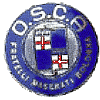
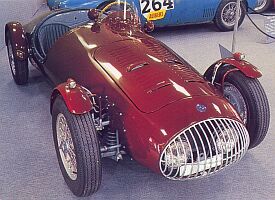 OSCA
was set up in December 1947 by the Maserati brothers Ettore, Ernesto and
Bindo (Alfieri sadly passed away in 1932) after they had sold their original
company (Maserati) to the Orsi
family in 1937 (they remained there for 10 years as consultants). Their
aim was to produce small capacity competition cars which they did with
considerable success, the first car being an open sports car with cycle-wings,
the MT4. With further developments an MT4-2AD (twin-cam) won the 1100cc
class in the 1950 Mille Miglia as well as numerous other victories.
OSCA
was set up in December 1947 by the Maserati brothers Ettore, Ernesto and
Bindo (Alfieri sadly passed away in 1932) after they had sold their original
company (Maserati) to the Orsi
family in 1937 (they remained there for 10 years as consultants). Their
aim was to produce small capacity competition cars which they did with
considerable success, the first car being an open sports car with cycle-wings,
the MT4. With further developments an MT4-2AD (twin-cam) won the 1100cc
class in the 1950 Mille Miglia as well as numerous other victories.
They also dabbled in Formula One, with normally-aspirated
4.5-litre cars in 1951 and 1952 but with less success. In 1952 they developed
a new 1987cc monoposto to meet the revised GP regs which achieved some
podium finishes in 1953.
Some cars also made it to the USA where their greatest
success was overall victory in the 1954 Sebring 12 hours, the drivers including
Stirling Moss ! The car was an MT4 1450.
In the mid-1950s OSCA concentrated on the 1500 class,
using a new 1490cc engine, although they also produced the 750S with a
70bhp 750cc twin-cam engine, which scored a class victory at Le Mans in
1958, driven by De Tomaso !
Road cars started to emerge from the factory in
1960, 128 examples of the 1600GT being built until 1963. Bodies were supplied
by Touring, Zagato, Fissore, Boneschi and Morelli whilst power came from
a twin-cam 1600 four-cylinder unit.
They also worked with Fiat for a time, modifying
Fiat 600s, and their engines were used in production Fiats from the late
1950's. The company became part of MV Agusta around 1963 and finally ceased
to trade in 1966.
MT4 & TN Types
1950 saw both the above engines getting a new cylinder-head
with two camshafts, the car becoming known as the MT4-2AD (or TwinCam).
The power outputs went up to 92bhp @ 6,600rpm and 100bhp @ 6,300rpm respectively.
The car got a new bodywork with integrated wheelarches, which gradually
changed with time. These cars were built from 1950 until 1956, and a small
number also received coupé bodies from various carrozzeria including
Frua, Michelotti and Vignale.
The capacity was again increased in 1953 when a 1453cc
version, with 110bhp @ 6,200rpm, was also produced. The ultimate MT4 had
to be the 1491cc version built in small numbers from 1954 to 1957. This
utilised twin plugs as well as twin camshafts and produced 120bhp @ 6,300rpm.
Externally the cars were basically the same as the smaller engined variants,
almost all MT4 cars sharing the same 2200mm wheelbase (only the early sohc
cars had a 100mm longer wheelbase).
The logical development of the MT4 saw the birth
of the TN in 1955. A revised and modified chassis (the 2200mm wheelbase
remained) was fitted with a new 1491cc dohc engine, now with 125bhp @ 6,300rpm.
The bodywork followed the same style as the MT4. These cars were only built
until 1957, although the engine was also used in some later MT4 cars.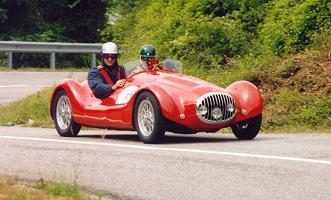 Emerging in the spring of 1948, the first Osca was
called the MT4 for Maserati tipo 4. It was a small open sports car powered
by a 1092cc four-cylinder engine which had a compression ratio of 11.5:1
and produced 72bhp @ 6,000rpm. It started winning at Naples that summer
driven by Villoresi. The following year the same engine had is capacity
increased to 1342cc, the power going up to 90bhp @ 5,500rpm. These cars
were a 'siluro' design (ie with exposed wheels covered by bicycle type
mudguards).
Emerging in the spring of 1948, the first Osca was
called the MT4 for Maserati tipo 4. It was a small open sports car powered
by a 1092cc four-cylinder engine which had a compression ratio of 11.5:1
and produced 72bhp @ 6,000rpm. It started winning at Naples that summer
driven by Villoresi. The following year the same engine had is capacity
increased to 1342cc, the power going up to 90bhp @ 5,500rpm. These cars
were a 'siluro' design (ie with exposed wheels covered by bicycle type
mudguards).
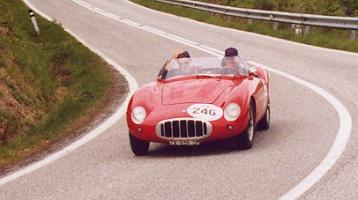 |
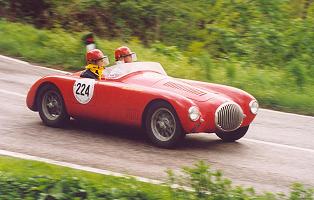 |
S Type
Considering a possible successor to the MT4, in 1956
a Tipo S was fitted with an increased capacity engine. By increasing the
bore to 70mm the overall capacity went up to 954cc, and the power to 78bhp
@ 7,200rpm. This car won the 1100 class in the 1957 Mille Miglia.
Given this success they went ahead and in 1957 the
S273, with a 1092cc engine producing 95bhp @ 7,000rpm, was released. The
chassis was basically still that of the 750 car, including the 2100mm wheelbase,
and although the empty weight had increased to 480kg it was still 50kg
less than the old 1100 MT4.
Two more variants of the S Type were also built towards
the end of its career. The S498 of 1949 used a 1995cc engine with 168bhp
and then 172bhp and a slightly longer wheelbase (2200mm). The body was
significantly lowered, needing a very noticeable bonnet bulge to clear
the engine, whilst the suspension was also revised. In 1960 the S-F392
emerged, a standard S Type chassis fitted with the 1600 dohc engine from
the 1600GT. Only two examples were constructed.
One of the more noticeable result of the 750 car
was a class win at Le Mans in 1958 when the car was driven by De Tomaso.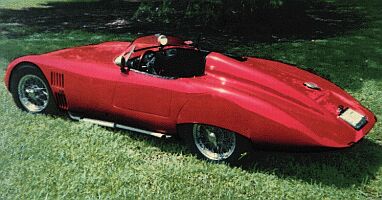 With
the S187, which emerged in 1956, OSCA extended their involvement in motorsport
into the 750 class. A complex frame made from small diameter tubes had
a 2100mm wheelbase and was fitted with a 749cc dohc engine which produced
70bhp @ 7,500rpm. The body had a very distinctive flat tail, which was
compared to a toothpaste tube..... The total empty weight was only
430kg. Drum brakes were fitted on all wheels, the suspension used coil
springs and telescopic dampers on all four corners and a solid rear axle
was fitted. This car continued to be built until 1958 with a variety of
evolving bodystyles. In 1959 a new 746cc engine, with 72bhp @ 7,600rpm,
was introduced, and a new body with clamshell front and rear sections was
used.
With
the S187, which emerged in 1956, OSCA extended their involvement in motorsport
into the 750 class. A complex frame made from small diameter tubes had
a 2100mm wheelbase and was fitted with a 749cc dohc engine which produced
70bhp @ 7,500rpm. The body had a very distinctive flat tail, which was
compared to a toothpaste tube..... The total empty weight was only
430kg. Drum brakes were fitted on all wheels, the suspension used coil
springs and telescopic dampers on all four corners and a solid rear axle
was fitted. This car continued to be built until 1958 with a variety of
evolving bodystyles. In 1959 a new 746cc engine, with 72bhp @ 7,600rpm,
was introduced, and a new body with clamshell front and rear sections was
used.
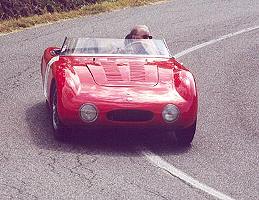 |
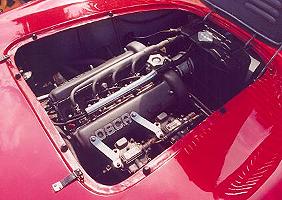 |
G, F2, 2000S and J Types
From 1959 to 1961 OSCA also produced around 15 Formula
Junior cars. Using a chassis inspired by the S-Type these cars were fitted
with a modified Fiat 1100 engine, the 1089cc ohv unit producing around
88bhp @ 6,800rpm.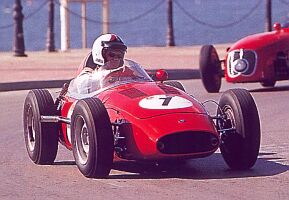 1951
saw OSCA produce a Grand Prix car, the G Type. This used a 4473cc V12 engine
with 330bhp @ 6,200rpm. The two cars were later given sports-car bodies
by Frua and Zagato, the former interestingly retaining its central driving
position.
1951
saw OSCA produce a Grand Prix car, the G Type. This used a 4473cc V12 engine
with 330bhp @ 6,200rpm. The two cars were later given sports-car bodies
by Frua and Zagato, the former interestingly retaining its central driving
position.
In the following year they chose the 2-litre formula,
producing a single seat GP car with a 1987cc dohc straight six engine with
170bhp @ 6,500rpm. Two examples were built.
In 1954 they decided to return to sports-cars with
the 2000S, a development of the F2. With a straight six 1987cc engine (dimensionally
identical to the F2 engine) which had 165bhp @ 6,500rpm, four of the cars
produced had bodies by Morelli and one by Frua. The wheelbase was also
the same 2250mm as the F2.
1600GT
Launched in 1960, the 1600GT was the first 'proper'
road car to emerge from the company. 128 examples were built until 1963.
Bodies were supplied by Touring (2), Zagato (98), Fissore (24 including
3 cabriolets), Boneschi (3) and Morelli (1) whilst power came from a twin-cam
1568cc four-cylinder unit (95bhp @ 6,000rpm). Various levels of competition
intent were built, regarding both weight and power output. More powerful
engines included the GTV which had 125bhp whilst the GTS had 140bhp @ 7,200rpm,
partly thanks to its twin plug ignition. All the cars had a 2250mm wheelbase.
At the 1963 Turin Motorshow OSCA presented a more
revised competition version, the 1600SP (below right). This still used
the 1568cc dohc engine, the 140bhp twin plug unit being intended. A four-speed
gearbox was standard, a six-speed was planned. The tubular chassis was
covered by a body from Zagato and the overall empty weight was reduced
to a mere 710kg. Only one example was constructed.
Click here for a series of pictures of a 1600GT in action.
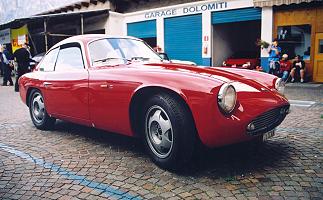 |
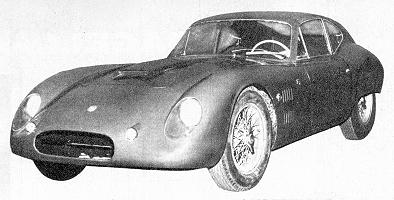 |
1600TC
Shown at the Turin Motorshow of 1964 this was another
coupé using Fiat 1600S mechanicals. The chassis used a central beam
('trave centrale' in Italian, hence TC) whilst the body was made from a
composite firbe reinforced material. The engine was the normal 1568cc dohc,
in this application with 125bhp @ 6,800rpm.
The wheelbase was 2400mm, tracks (front/rear) 1340mm/1320mm,
total length 4350mm, width 1590mm, height 1220mm and an empty weight of
840kg.
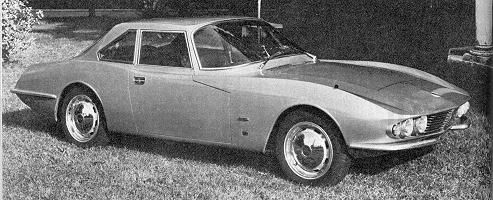 |
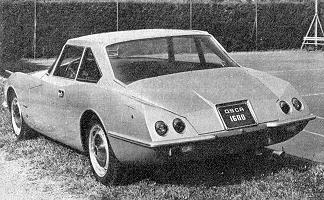 |
1050 Coupé and Spider
Also at the Turin Motorshow of 1964 were two smaller
cars, a plastic bodied coupé and a metal bodied spider, the latter
designed by Touring.
Both cars were powered by the same 1057cc four-cylinder
engine with 63bhp @ 5,800rpm.
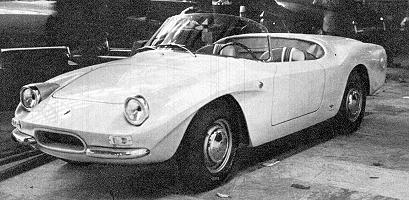 |
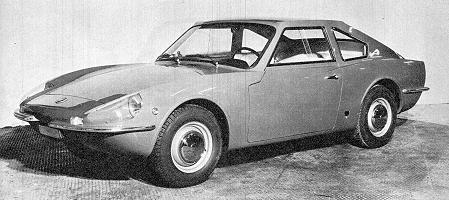 |
OSCA-MV Coupé and Spider
Following the purchase of OSCA by MV work continued for a short time on new models. At the Turin Motorshow
of 1965 two models were on display, a spider and a coupé, both designed by Zagato.
These were both powered by the four-cylinder 1700 engine from the Ford Taunus, with the power output increased to 95bhp @ 5,800rpm. The engine was positioned at
the front of the car, whilst the four-speed gearbox and differential were located together at the rear. Independent suspension and disc brakes were
fitted all round. The coupé was 4050mm long and weighed 710kg whilst the spider was 3800mm long and weighed 640kg. Manufacturer top speeds
were 175km/h for the spider and 180 for the coupé. Production was scheduled to start in the spring of 1966.
Click here for pictures.
2500 GT (Dromos)
In 1999 there emerged a new car with the OSCA badge
on the bonnet. The OSCA name had been sold to MV Agusta in 1963 but was resurrected
by GMP Automobili srl, the car originally known as the 2500GT then later christened 'Dromos'.
Financial backing came from a Japan businessman with Colucci (ex-Abarth),
Spada (ex-Zagato designer), Luca Zagato (son of Gianni) and others
involved. The car was an all new small (4090mm long, 1150mm high and 1760mm wide) two seat coupé powered by a Subaru 2457cc
flat four engine (tuned by STi to give 187bhp) positioned behind the cockpit. The chassis was built by a reborn Touring
using their famous superleggera construction with a multitude of small diameter steel tubes. Suspension
was by double wishbones all round and the rest of the car followed such
competition based trends. An ultra light weight of 680kg (45% front/55% rear) promised more
than adequate performance. A single running prototype was built and tested by various magazines in 2001 but nothing more came of the project.
Various pictures of the Dromos
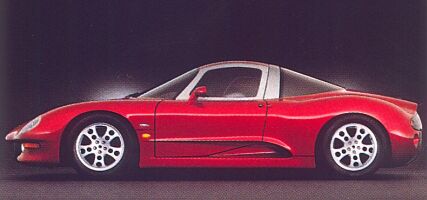 |
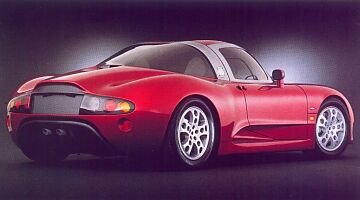 |
Links
If you know of any relevant websites please send us the details.
For more pictures of various OSCA cars, see our Silver Flag, Trofeo Lumezzane, Giro Storico di Lombardia, Mille Miglia 2001 and 2002 and Trofeo Aido picture galleries.
OSCA comment form
Your Comments
Any comments ?
Copyright © 2000 to 2008 CarsfromItaly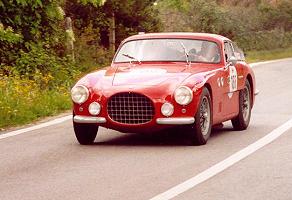 Use
the buttons at the top to navigate further, or
Use
the buttons at the top to navigate further, or